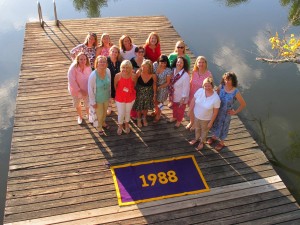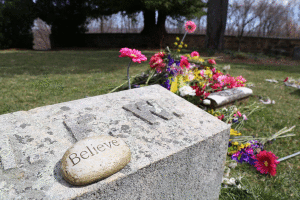Never ever depend on Governments or institutions to solve any major problems. All solutions come from the passion of individuals. – Margaret Mead
While there are many issues to examine with respect to the President, Board and operations of Sweet Briar College, it seems fitting to focus for a moment on the efforts to SAVE the College. I feel I can take a little break from my ranting against the horrible leadership, governance and lack of proper administration for a bit. The legal team inspires confidence and there national experts rolling up their sleeves and taking aim at those issues. Most recently it is the Amherst County Board of Supervisors. I thought today I would share a glimpse at the amazing work being done to #saveSweetBriar.
Yesterday I attended a farewell gathering of a colleague at the University of Maryland and was asked by many in the room about Sweet Briar. I found myself describing my efforts and those of my fellow alumnae and felt my spirits rising with each retelling. It is a story built on determination. It is a saga filled with drama and intrigue. It is a case study in alumni activism that will likely become an inspiration for our sister Colleges and other small liberal arts Colleges around the country. I can also confidently say we have worthwhile lessons to share with colleagues around the WORLD. I met a visitor from the University of Manchester in England who asked me to share some of the key lessons learned. The Saving Sweet Briar efforts are the very example of what Margaret Mead famously wrote. Wait for it… (this isn’t the quote you are thinking I am going to use),
“Never ever depend on governments or institutions to solve any major problems. All social change comes from the passion of individuals.” — Margaret Mead.
I have served on many boards from schools to arts organizations to sports teams. Alongside many passionate parents (and some alumni), I have added my weight to a collective effort to move something forward. Never in my 30 years of volunteerism or professional experience have I seen the likes of the mobilized alumnae of Saving Sweet Briar. Allow me to pull back the curtain and share a few examples….
Saving Sweet Briar, Inc. Within days of the announcement of the Sweet Briar College President and Board’s decision to close, a group of courageous women banded together to formally fight the closure. First, they opened up their pocketbook to pay for necessary legal counsel in Troutman and Sanders. Second, they established a Board. Third, they applied for 501C3 status for Saving Sweet Briar, Inc. They had a vision and mission statement, a segment of which is here:
Saving Sweet Briar, Inc. was established to block the closure of Sweet Briar College and provide accurate information to students, faculty, and alumnae about the true financial condition of Sweet Briar College and the viable alternatives to closure. The organization is also dedicated to raising the necessary funds to fight the closure and help erase the school’s financial shortfall. Saving Sweet Briar, Inc. is also committed to identifying highly talented individuals who can serve on the Sweet Briar College Board of Directors to help lead an immediate turnaround for the institution while developing a longer term strategy with input from key stakeholders. Success in achieving our mission will ensure that future generations of women can proudly call themselves Sweet Briar alumnae.
In their own words, they all wish to be “out of a job” and see themselves as temporary stewards. An example of the kind of top-notch experts they have hired to provide advice and guidance for the future include a forensic accountant, R. Stephen Spitzer, and a college turnaround expert with solid examples of other institutions. The Board vets candidates for a new Board; they have a list of interested College Presidents with proven turnaround experience; experts on a number of fields are being vetted to provide real advice for the future.
The call to action is clear:
Spread the word
Share your Sweet Briar Story with your friends on social media using the hashtags #savesweetbriar and #thinkisforgirls
Volunteer
Do you have particular talents that would help us with our mission to save our school? Contact us.
Raise Money
We need money to support our school! Given the state of financial aid and higher ed, Sweet Briar needs to grow its endowment to stay viable. Crowdfunding information to follow.
Help Keep Our School Alive
There are over 500 women on campus who need our support. Help us help them keep our school alive.
In the meantime, the thousands of alumnae have managed to create an organizational structure rivaling some of the largest Universities (I speak with experience working for a B1G school, University of Maryland and serve on the University Senate). There are literally HUNDREDS of Committees of EXPERTS in their professional areas reporting up through Chairs who compile the information into master documents. The first of these documents, a Strategic Plan, was delivered to the Saving Sweet Briar board in time for the first injunction hearing. There are PhD experts, attorneys, professional fundraisers, accountants, social workers, psychologists, psychiatrists, medical doctors, coaches, scientists, elected officials, C-suite executives of every type providing advice that the College — any College or nonprofit — would pay hundreds of thousands of dollars to secure (I say this with experience having watched schools hire consultants for narrowly focused work and deliverables). Sweet Briar College itself by the Board’s own admission paid over $1 MILLION for a report that was never concluded and the Board members were not able to keep after reading it and voting to close the College.
Committee Structure. This is a case for the power of social media if there ever were one. Facebook, in particular, has provided the platform for alumnae to organize their efforts. Early in the process, pages were created for experts to share suggestions in different areas in the “Saving SBC Professional Roundtable” (a closed group so not hyperlinked here). Categories include every aspect of operations:
Academic Affairs, Admissions, Development/Fundraising, Diversity, Career Counseling, College Placement, Grounds & Facilities, Information Technology, Land (Creative Use of/Maintaining), Legal, Student Affairs, Social Life.
Each group has professionals who have spent their careers in these areas with best practices to share. The alumnae’s willingness to help is not just lip service. Examples of alumnae offers and efforts to assist include:
Deferred maintenance problems? Check. Habitat for Humanity-like plans for improvement including painting, plastering and even building repair by licensed contractors paid for by alumnae or their own companies. These are documented offers to help as they cannot execute these plans without coordination from the facility leadership.
Admissions/Recruitment problems? Check. Alumnae from around the Country have offered to reinvigorate a dormant network of volunteers to attend College Fairs, visit area feeder schools (and aspirant feeder schools), house admissions staff traveling, personally write interested students and their families. In addition, the Alumnae Angel Network are alumnae who sponsor students needing support transferring to another College. Even if this might mean losing a student needed for the future, the movement is supporting the current students in tangible ways.
Fundraising problems? Check. As of this writing, over $1 million in cash is in the Saving Sweet Briar accounts. Over $10 million in pledges over five years are being held in trust by Saving Sweet Briar for the College once the closure decision is reversed and there is a Board and Administration committed to the future. A Major Donor Task Force (of which I am a part) has weekly conference calls to coordinate outreach to past donors to the College and those who care and aren’t even affiliated. A Regional Task Force from each state writing to their residents, particularly those not on social media. Liaisons to classes (a traditional way to communicate with alumnae) share information on a weekly and even daily basis with links to give, participate and support. All of this has been accomplished without the tools fundraisers usually have (I know because I am one). For example, a donor database has been faithfully RECREATED through years of magazines publishing giving information and even programs from past campaign celebrations kept as keepsakes — now data for a defacto giving database. It is INCREDIBLE to watch and witness. This is worthy of its own blog post, stay tuned.
Communications Strategy? Check. The initial news stories reported the Board’s decision to close. The news of the alumnae outcry and mobilization was relegated to the comment section of most stories. However, the tide has turned. Now, major news outlets are reporting on the success of the alumnae efforts and on the amazing accomplishments of our alumnae, the morning of my writing the New York Times wrote about our alumnae and the efforts to save the College. This type of media battle and reversal of message does not happen easily. It has occurred through professionals and passionate individuals working with contacts to share opinion, provide worthwhile facts to report, verify stories and share perspective. Interestingly, the headlines of some of the earlier stories have changed from “College imploding” to “Alumnae Fight Closure”.
Conspiracy Theories? Check. One of my favorite movements within the Saving Sweet Briar collective, is a group a la Erin Brokovich that dedicates itself to researching the “back story”. The team (which includes some with investigative journalism experience) posts pieces of documents, theories, lists, etc. and a broad network do their further work and reports results. Some of these get passed along – once vetted — for journalists or the Saving Sweet Briar Board. Just when my own efforts to Save Sweet Briar might flag or my confidence wane or my enthusiasm might be dampened by some new comment by the “President”, someone from the group will post some new theory or angle that gets me MAD. They have even inspired and commissioned political cartoons. I have the one of the women turning over the rock next to my phone (for when I “dial for dollars”).
The efforts of the alumnae are truly inspiring.
Imagine – just imagine – if their efforts were harnessed BEFORE the College announced it must close.
Imagine if the Board took stock of this advice and reconsidered their decision?
Imagine if YOUR organization harnessed your stakeholders?
Sweet Briar is receiving DAILY national attention. Sweet Briar students, faculty, staff, alumni and community are rallying to share their expertise. The future IS bright and there is much to hope for with this kind of passion.
At this point, I cling to the other Margaret Mead quote – the one you know by heart – because I am seeing it validated on an hourly basis.
Never doubt that a small group of thoughtful, committed citizens can change the world. Indeed it is the only thing that ever has. — Margaret Mead
Our aim is not the world for now. For now it is a small piece of the planet located in Southern Virginia, Sweet Briar.
Stacey Sickels Locke, CFRE, is a proud graduate of Sweet Briar College, Class of 1988. She served as an employee of the College in the early 1990s working on the $25 million Campaign. During that time, she solicited many leadership gifts which make up the current endowment and she feels a sense of duty that those donations are not used for the closure of the College or for any other purposes than the donors intended. Since then, she has spent her career building support for higher education and the nonprofit community as a staff member and consultant for boards. As a volunteer, she has served Sweet Briar since graduation as a fundraiser, admissions ambassador and now advocate for the #saveSweetBriar movement. She is a member of the Association of Fundraising Professionals (AFP), is affiliated (through the University of Maryland) with the Council for Advancement and Support of Education (CASE) and holds a Certified Fund Raising Executive (CFRE) certification from CFRE International.

Share this....













